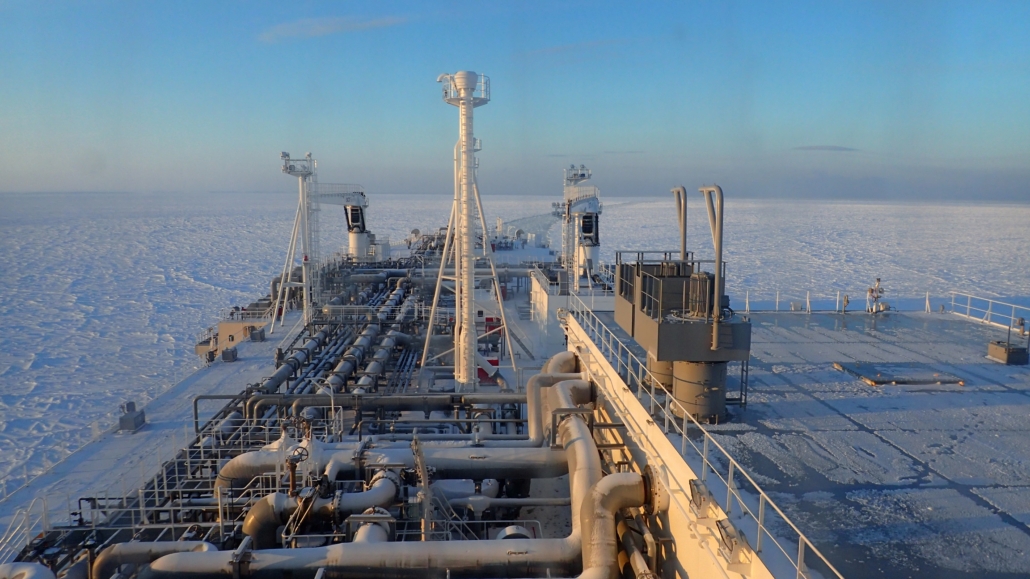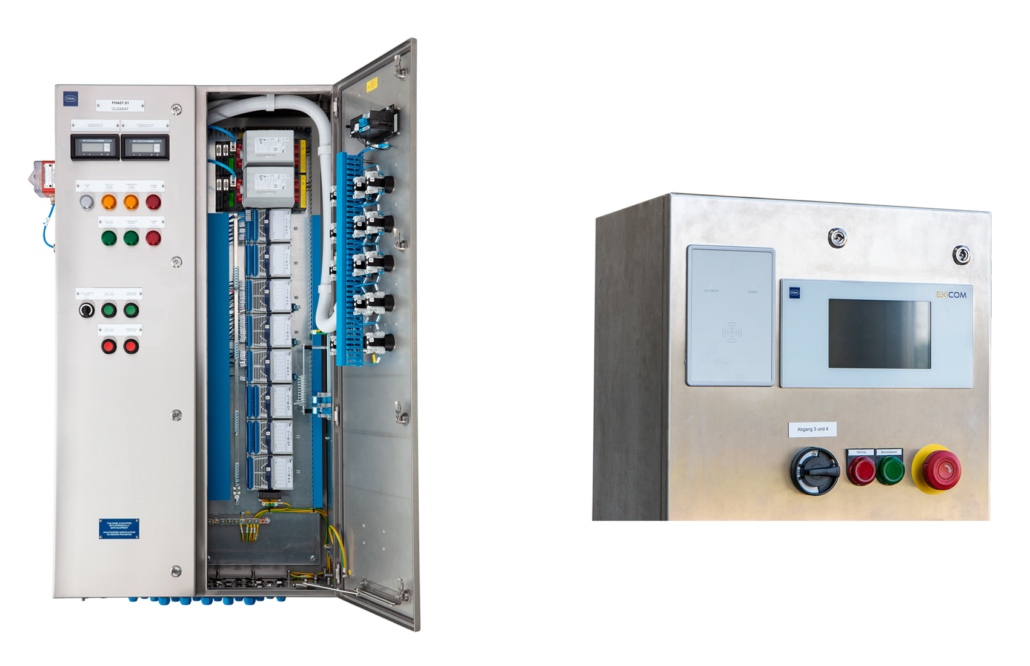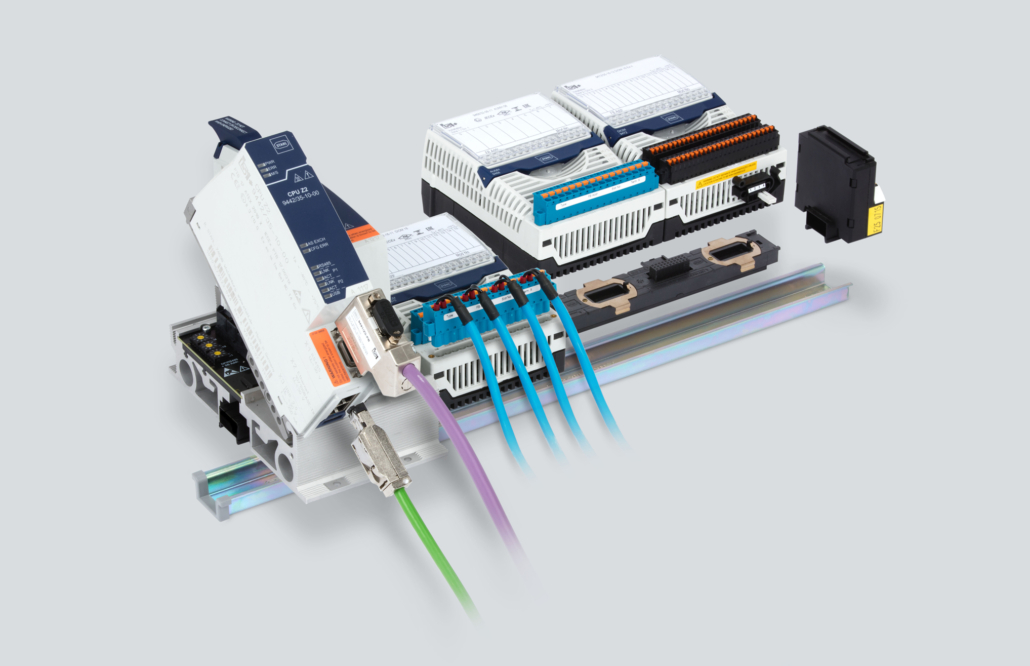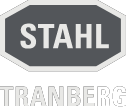Ex-protected Automation Systems for the Maritime Energy Transition
Published: July 29, 2020
Category: News
By Isabelle Simonsen
Position:
To protect the environment and the planet’s water, the shipping industry is increasingly switching to drives that use liquefied natural gas (LNG). Retrofitting ships powered by heavy fuel oil in order to use the new, alternative drive type known as a “Fuel Gas Supply System” (FGSS) means that there will be additional hazardous areas on board that require the integration of explosion-protected I/Os and display systems in the ship’s control system and on-board Alarm Control Monitoring.
With the IS1+ Remote I/O system, HMI terminals and suitable enclosures and equipment, R. STAHL offers a comprehensive solution for integrating hazardous areas in Zone 1 and 2 into the control systems that have been in use in the maritime industry for years.
For around ten years, the shipping industry has been undergoing significant change in the way it considers the fuel it uses – with new insight into how environmentally unacceptable the combustion of heavy fuel oils in shipping motors is, liquefied natural gas (LNG) and liquefied petroleum gas (LPG) are receiving more and more attention as a maritime fuel. The use of heavy fuel oil not only causes around two to three percent of global CO2 emissions; it also releases fine dust, nitrogen oxide and sulphur dioxide that significantly contribute to air and water pollution. For this reason, legal restrictions on the use of heavy fuel oil are becoming ever stricter.
In 2006, the International Maritime Organization (IMO) tightened the specified limiting values for the permissible sulphur content in ship fuels in a step by step process, and expanded the restrictions on the use of fuel on inland waters, in EU seaports and in Sulphur Emission Control Areas (SECAs) such as the North Sea and Baltic Sea or the Californian coastal region. As a result, ship owners must refuel their ships with reduced-sulphur marine diesel, which is much more expensive.
Most recently, in January 2020, the IMO introduced stricter environmental requirements that regulate the use of heavy fuel oil even more and force owners to use less harmful fuels.
Liquefied natural gas (LNG): An environmentally friendly alternative
In light of the ever stricter limiting values and restrictions, more attention is being paid to LNG and LPG drives as an alternative for shipping, or as a transitional technology that conserves resources. Compared to conventional maritime fuels, the use of gas-powered combustion engines reduces fine particle and nitrogen oxide emissions by up to 90% and reduces sulphur dioxide emissions by 100%.
Aside from the environmental damage caused by heavy fuel oil and the increasing cost of maritime diesel, LNG fuel also offers benefits in terms of the cost; for instance, there is no need to install an exhaust gas cleaning system, which can be expensive.
What’s more, gas drives can also be used in ports without needing to consider the ship’s power supply. This is important because more and more port cities are considering making the use of costly shore-side power supplies mandatory for ships in order to prevent air pollution. Of course, the type of ship and the speed of the wider gas infrastructure will determine when the retrofitting and installation of LNG drives will begin to yield a profit.
However, current model calculations assume that gas drives on ships will pay off after an average of five years, based on strict environmental requirements, the price of maritime diesel and decreasing costs of LNG supply. In 2019, of the approximately 60,000 cargo ships in operation around the world, only 321 were powered by LNG drives, with orders in place for a further 510 ships.
Process data from the FGSS
The Fuel Gas Supply System (FGSS) that supplies fuel to the motors in the LNG drive comprises the gas tank itself, as well as evaporators, compressors, pumps and heat exchangers. The temperature, pressure and flow values measured in these system parts, the valve positions, the device statuses, etc. must be provided to the ship control system and the self-sufficient Alarm Control Monitoring System (ACMS), if present.
The FGSS represents a hazardous area due to the high volatility and ignitability of the conveyed gas; as a result, the measured values must only be determined and transmitted using explosion-protected, often intrinsically safe sensors and network components. This involves not only transmitting the sensor data from hazardous zones to control centres, but also providing the recorded data, visualisation and monitoring to the Alarm Control Management within Zone 1.
Reliable explosion protection solutions for maritime safety
R. STAHL, an internationally leading supplier of explosion-protected components and customer-specific system solutions, has already been implementing remote I/O installations on ships and offshore platforms for 30 years. Today, R. STAHL’s customers include globally active companies in heavy industry who use process control systems or ship control systems with the Ex-protected products from the Waldenburg-based company.
With the IS1+ Remote I/O system for Zone 1, the manufacturer has developed a solution for intrinsically safe sensor/actuator networking in hazardous systems that has become an established solution in the maritime sector; it has already been tried and tested in use on several hundred LNG tankers and in many other applications in the oil and gas industry.
What’s more, R. STAHL offers its customers network components, operating terminals, protective enclosures with international approval and all the equipment required to install Ex-protected data transmission in Ex zones, including safety cameras, lamps, or control and display elements for hazardous areas – all from a single source.
Korean shipbuilders rely on IS1+
For sensor data transmission from the FGSS to command levels and ACMS, many shipbuilders now prefer R. STAHL’s remote I/O system – including in South Korea, where shipyards are recording increasing demand for LNG-powered ships. Many shipbuilders already have good experience with the remote I/O system, which is preferred and recommended by globally active suppliers.
Against this backdrop, over the past year, two renowned companies in heavy industry – and incidentally also two of the largest shipyard operators in South Korea – approached R. STAHL. R. STAHL first established a business relationship with one of these companies ten years ago when R. STAHL was tasked with the technical monitoring for a project; the customer was extremely satisfied, which led to an increase in orders within the maritime sector.
The current request involves adjusting the specifications of existing ship control systems and the FGSS connection for use with R. STAHL products; for quality assurance reasons, many customers are requesting a FGSS connection that works with the highly recommended Remote I/O systems from the German manufacturer.
Automation systems from R. STAHL for the maritime energy transition – even under extreme environmental conditions.
R. STAHL has been installing remote I/O systems on ships and offshore platforms for over 30 years and offers remote I/O station with integrated, modern visualization for use in hazardous areas.
The IS1+ Remote I/O system for modern process automation offers support for PROFINET, EtherNet/IP, Modbus TCP and PROFIBUS DP.
Remote I/O modules at sea
The IS1+ series Remote I/O systems feature seawater-resistant enclosure materials, a vibration-resistant design and resistance to electromagnetic influence – perfect for use in the maritime industry. This takes into account even the stricter EMC requirements, thanks to the on-board wireless equipment and sea rescue call frequency.
All required ship approvals and certificates according to the EU RO Mutual Recognition Group’s requirements and international explosion protection certificates guarantee problem-free use of the system. The Group includes twelve classification companies, such as DNV-GL, ABS and ClassNK. After detailed consultation with the manufacturers, R. STAHL initially received an order from the customer at the end of 2019 to outfit four freight ships, one tanker and five container ships. The remote I/O systems for use in Zone 1 of the FGSS are supplied by R. STAHL in suitably sized enclosures, ready for installation.
The 9440/22 series CPU modules approved for use in Zone 1/Div. 1 can be used as gateways for connecting the remote I/O systems to the automation system. For on-site visualisation and FGSS alarm management in Zone 1, R. STAHL recommends that its customers opt for the ET-698 operating station, a thin client from the SHARK device platform certified according to ATEX, IECEx, ABS and DNVGL. The shock- and vibration-resistant operating units in the seawater-resistant IP66 enclosure ensure that the 21.5 inch display and function keys are protected by a chemically hardened, reflex-free glass pane.
The devices use multi-mode fibre optics for data transmission. With its tried-and-tested IS1+ Remote I/O system R. STAHL offers a simple solution for all control or ACM systems that enables signals from hazardous areas to be connected via PROFIBUS DP, Modbus RTU or Ethernet Modbus TCP, EtherNet/IP and PROFINET.
In combination with coordinated, extremely robust HMIs and all required network components in explosion-protected versions, the manufacturer enables problem-free, convenient access to process data in the environment immediately surrounding the applications.







